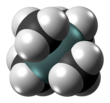
| |||
| |||
| Names | |||
|---|---|---|---|
| Preferred IUPAC name Tetramethylsilane | |||
| Identifiers | |||
| CAS Number | |||
| 3D model (JSmol) | |||
| Abbreviations | TMS | ||
| Beilstein Reference | 1696908 | ||
| ChEBI | |||
| ChEMBL | |||
| ChemSpider | |||
| ECHA InfoCard | 100.000.818 | ||
| EC Number |
| ||
| MeSH | Tetramethylsilane | ||
| PubChem CID | |||
| RTECS number |
| ||
| UNII | |||
| UN number | 2749 | ||
| CompTox Dashboard (EPA) | |||
InChI
| |||
SMILES
| |||
| Properties | |||
| Chemical formula | C4H12Si | ||
| Molar mass | 88.225 g·mol | ||
| Appearance | Colourless liquid | ||
| Density | 0.648 g cm | ||
| Melting point | −99 to −102 °C (−146 to −152 °F; 174 to 171 K) | ||
| Boiling point | 26 to 28 °C (79 to 82 °F; 299 to 301 K) | ||
| Solubility | organic solvents | ||
| Structure | |||
| Molecular shape | Tetrahedral at carbon and silicon | ||
| Dipole moment | 0 D | ||
| Hazards | |||
| GHS labelling: | |||
| Pictograms |   
| ||
| Signal word | Danger | ||
| Hazard statements | H224, H302, H411 | ||
| Precautionary statements | P210, P233, P240, P241, P242, P243, P264, P270, P273, P280, P301+P312, P303+P361+P353, P330, P370+P378, P391, P403+P235, P501 | ||
| NFPA 704 (fire diamond) |
 | ||
| Flash point | −28 to −27 °C (–18 to –16 °F), vapor may be pyrophoric | ||
| Related compounds | |||
| Related silanes | |||
| Related compounds | |||
| Except where otherwise noted, data are given for materials in their standard state (at 25 °C , 100 kPa).
| |||
Tetramethylsilane (abbreviated as TMS) is the organosilicon compound with the formula Si(CH3)4. It is the simplest tetraorganosilane. Like all silanes, the TMS framework is tetrahedral. TMS is a building block in organometallic chemistry but also finds use in diverse niche applications.
Synthesis and reactions
TMS is a by-product of the production of methyl chlorosilanes, SiClx(CH3)4−x, via the direct process of reacting methyl chloride with silicon. The more useful products of this reaction are those for x = 1 (trimethylsilyl chloride), 2 (dimethyldichlorosilane), and 3 (methyltrichlorosilane).
TMS undergoes deprotonation upon treatment with butyllithium to give (H3C)3SiCH2Li. The latter, trimethylsilylmethyl lithium, is a relatively common alkylating agent.
In chemical vapor deposition, TMS is the precursor to silicon dioxide or silicon carbide, depending on the deposition conditions. In the formation of silicon carbide, carbosilanes, such as 1,3,5,7-tetramethyl-1,3,5,7-tetrasilaadamantane, are observed as intermediates.
Uses in NMR spectroscopy
Tetramethylsilane is the accepted internal standard for calibrating chemical shift for H, C and Si NMR spectroscopy in organic solvents (where TMS is soluble). In water, where it is not soluble, sodium salts of DSS, 2,2-dimethyl-2-silapentane-5-sulfonate, are used instead. Because of its high volatility, TMS can easily be evaporated, which is convenient for recovery of samples analyzed by NMR spectroscopy.
Because all twelve hydrogen atoms in a tetramethylsilane molecule are equivalent, its H NMR spectrum consists of a singlet. The chemical shift of this singlet is assigned as δ 0, and all other chemical shifts are determined relative to it. The majority of compounds studied by H NMR spectroscopy absorb downfield of the TMS signal, thus there is usually no interference between the standard and the sample. Similarly, all four carbon atoms in a tetramethylsilane molecule are equivalent. In a fully decoupled C NMR spectrum, the carbon in the tetramethylsilane appears as a singlet, allowing for easy identification. The chemical shift of this singlet is also set to be δ 0 in the C spectrum, and all other chemical shifts are determined relative to it.
References
- Elschenbroich, C. (2006). Organometallics. Weinheim: Wiley-VCH. ISBN 978-3-527-29390-2.
- Fritz, Gerhard; Matern, Eberhard (1986). Carbosilanes. doi:10.1007/978-3-642-70800-8. ISBN 978-3-642-70802-2.
- Mohrig, Jerry R.; Noring Hammond, Christina; Schatz, Paul F. (January 2006). Techniques in Organic Chemistry (Google Books excerpt). Macmillan. pp. 273–274. ISBN 978-0-7167-6935-4.
- ^ "The Theory of NMR - Solvents for NMR Spectroscopy". Archived from the original on 2015-01-23. Retrieved 2014-01-23.

